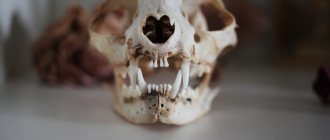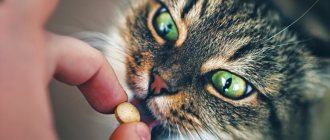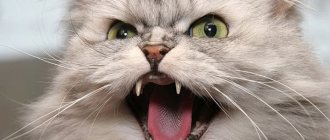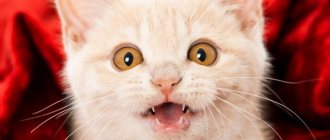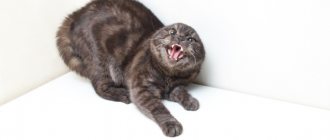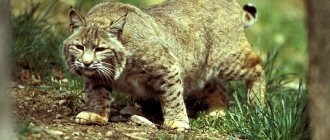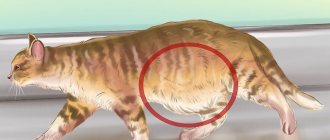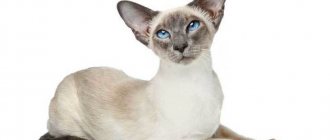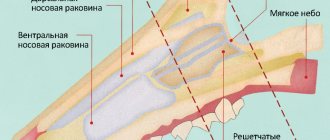- External structure of a cat Cat's head Eyes
- Ears
- Language
- Jaws and teeth
- Paws and claws
- Skeleton
- Reproductive system
Representatives of the cat family are the most graceful animals in the world.
High jumps, amazing balance, lightning-fast movements, silent movements - this is not a complete list of the capabilities that cats have. This is primarily due to the peculiarities of the cat’s structure. The internal organs in their location and functions are similar to the structure of other mammals, however, they have a number of special differences. The cat's body has more than 500 muscles of varying sizes, which allows it to perform all these different physical activities that sometimes amaze spectators. The cat’s brain is also very developed, it reacts quickly, coordinates the actions of the animal, using the structure of the body along with all its advantages. It is precisely because of the speed of reaction that they probably say that “a cat has 9 lives,” because it can group itself in an instant and thereby save its life.
Cat bones and joints
The graceful silhouette of cats is formed by the skeleton and muscles. Kittens can differ significantly in their proportions from adult animals. Often teenagers seem angular and awkward. A newborn kitten already has the necessary set of muscles, ligaments, bones and joints. During the growth process, their number does not increase, only their sizes change.
Bones are a hard organ consisting primarily of bone tissue. The bone structure also includes nerves, blood vessels, cartilage, and periosteum. Bone tissue is made up of minerals (mainly calcium and phosphorus).
The skeleton forms the skeleton of a cat's body. Bones perform not only a musculoskeletal function, but also a protective function. The bones of the skull protect the brain from mechanical damage, and the ribs help keep the heart and other internal organs intact. On average, cats have about 240 bones. Their exact number depends on the length of the tail of each individual individual.
At the ends of the bones there is an epiphysis - soft cartilaginous tissue. It is she who is responsible for the growth of bones in kittens. Typically, active bone growth in cats is observed before they reach one year of age. Due to the soft epiphysis, the bones of kittens are very fragile, so they are often injured. After reaching one year of age, the pineal gland is saturated with minerals (mainly calcium) and hardens.
Cats have the following number of vertebrae:
- 7 cervical;
- 13 breast;
- 7 lumbar;
- 3 crosses;
- up to 24 tail.
The spine and skull serve to protect the central nervous system. The thoracic vertebrae, ribs and sternum form the rib cage. Cats do not have collarbones, and therefore the limbs and chest are attached to each other using strong muscles and tendons. Thanks to this feature, cats can jump from great heights.
The forelimbs consist of:
- radius;
- humerus;
- ulna;
- shoulder blades;
- wrists;
- the bones of the paw itself.
The hind limbs consist of:
- pelvic bone;
- hips;
- shins;
- kneecap;
- heels;
- metatarsal bones;
- phalanges of fingers.
Cats literally walk on their toes rather than stepping onto surfaces with their entire foot. The cat has 5 toes on the front paws (one of the toes is shortened and does not touch the surface when walking), and on the hind paws there are 4 toes (the thumb is missing, but you can see the heels). On the fingers there are leather pouches in which the claws are hidden. If desired, the cat can release them instantly.
The skull consists of the brain and facial sections. The first has 11 bones, and the second 14. The kitten erupts its teeth at three weeks of age. There are 26 of them in total. At about six months of age, they are completely replaced by permanent teeth.
Cats are predators, and the structural features of their jaw are associated with this fact. An adult animal has 30 teeth: 12 incisors, 4 canines, 10 premolars and 4 molars.
Joints are movable joints of the skeleton. In cats, there are three types of joints: synovial and cartilaginous, sutures. It is thanks to the joints that the cat's body is so mobile.
The cartilaginous joints of cats are highly flexible, allowing the animal to take various “uncomfortable” positions. The sutures are motionless; they are located between the fused parts of the skull. They have a fairly fibrous structure.
Synovial joints serve to move bones together. At the junction, the bone is covered with cartilage tissue, which is surrounded by a smooth capsule filled with synovial fluid. Due to the mobility of these joints, the cat can run fast and jump high.
We recommend the article: Why does a cat constantly stick out its tongue?
Animal spine
In the structure of a cat's skeleton, the longest element is the spine. It has incredible flexibility, which is due to the presence of tiny movable bones. This part of the cat's skeleton is formed from many vertebrae, divided into sections such as cervical, thoracic, lumbar, sacral and caudal. Each of them has certain characteristics and deserves special attention.
It is noteworthy that the tail is considered an integral part of the cat's spine. This organ is responsible for maintaining the animal’s balance during jumps and falls.
Cervical region
This section is formed by the larger 7 vertebrae, which are responsible for the support and mobility of the animal’s head. Two of them, called epistropheus (axial, axis) and atlas, are endowed with the unique ability to rotate 180 degrees. These vertebrae are connected to each other by a thin finger-like process.
Due to the increased fragility of such a connecting element, the epistrophy and atlas are considered the most vulnerable parts of the cat’s body, since when injured (impacts, falls from a great height), there is a high probability of damage to the process connecting them, which leads to a fracture of the cervical vertebrae and the death of the animal.
It is for this reason that experts do not recommend using a belt in this part of the cat’s body. Despite its flexibility, the cat's skeleton consists of several extremely fragile elements, which in some cases can be damaged. Under normal conditions, the animal's neck is completely safe. Unlike a belt, a flea collar is completely safe for such a pet.
Chest and ribs
This section of the cat's spine includes 13 vertebrae. 24 rib bones are attached to them on both sides. The first 5 pairs of ribs are called true, because they are attached to the sternum. The remaining ribs, which have an arched shape, are usually called false (false). Thanks to this structure of the rib bones, the flexibility of the animal’s body and its ability to turn around even in conditions of very limited space are ensured.
Lumbar and sacral regions
The lumbar spine of a cat includes the 7 largest vertebrae. As they approach the tail, their size increases. These elements have special protrusions on the sides. They are designed to attach the muscles and internal organs of the abdominal cavity. A high degree of mobility of this section is achieved due to the fact that elastic cartilage pads are attached to its vertebrae.
Unlike the flexible lumbar, the sacral region is formed from 3 fused vertebrae, between which there is a rigid intervertebral joint. This feature is due to the fact that the cat’s hind legs are attached to this area, which bear the main load during its movement, especially during jumping.
Caudal vertebrae
The caudal spine of the cat's skeleton plays one of the main roles in maintaining the animal's balance during jumps and falls from heights. The ideal jumping ability of cats is ensured by strong muscle ligaments, and the ability to unhindered complex movements (bending and rotation) is ensured by intervertebral cartilaginous pads.
The number of vertebrae in this section directly depends on the characteristics of the breed of representatives of the cat family. There are cat breeds that do not have them at all. On average, the average animal has about 20–25 caudal vertebrae. The tail is a kind of steering device for a cat. It helps him balance while walking and falling. This explains the fact that most short-tailed or tailless representatives of this family are more clumsy compared to their counterparts with a full tail.
This does not limit the function of this body. It not only helps the cat balance, but also serves as a kind of litmus test for its mood. If an animal furiously beats its tail on the floor or vigorously waves it from side to side, it means that it is in an irritated or aggressive state and it is better not to approach it.
If your pet tucks its tail to its hind legs, it is most likely that it is very frightened by something and should be calmed down.
Cat muscles
It is the muscles, of which there are more than five hundred in cats, that are responsible for the movement of all parts of the animal’s body. They are divided into two types: smooth and striated.
Smooth muscles cover the internal organs. The cat cannot control them consciously. Striated muscles are attached to the skeleton and are responsible for the movement of the animal. Muscles are attached to bones by tendons made of fibrous tissue.
Cats have an unusual structure of the shoulder girdle. If a person has collarbones, with the help of which the limb is attached to the skeleton, then in cats the forelimbs are connected to the body with the help of muscles. This has to do with the way the cat moves. Thanks to this structure of the shoulder girdle, cats become more flexible. They can easily flip over in the air and use their front legs as a shock absorber.
The muscles on the hind legs are strong, thanks to this the animal can quickly gain speed and make high jumps.
Limb structure
There are two sections in the skeleton of a cat’s limbs:
A belt of the forelimbs (shoulder), the peculiarity of which is the elastic fastening of the limbs, which is necessary for cats for safe jumping and comfortable landing. It is represented by the scapula, humerus, radius and ulna (forming the forearm), and the hand. The latter consists of the wrist, metacarpus and phalanges of the fingers, of which there are only 5 on the forelimbs.
Another unique feature of feline anatomy is the absence of a full collarbone. It is represented by two non-functional bones that are not attached to the shoulder joint, but are located freely inside the muscles. The shoulder blades are attached to the spine by muscles, ligaments and tendons, due to which the shoulders have virtually no restrictions in movement.
Interesting! Due to the unique structure of the collarbone, a cat is able to crawl into even the narrowest holes if the animal’s head fits in, since it is the latter that is the most voluminous, but not subject to deformation, part of the body.
The girdle of the hind limbs, which, unlike the shoulder girdle, is rigidly and motionlessly attached to the sacrum. It includes: the pelvic and femur bones, the kneecap, the tibia and fibula, the tarsal and metatarsal bones, to which the phalanges of the fingers are attached. The pelvic bones of the hind legs are longer and better developed compared to the front legs, and the metatarsal bones are more massive, which is associated with the characteristics of the animal’s movement (in particular, jumping). Due to this structure of their limbs, cats can move quickly in horizontal and vertical planes, which is why they are excellent tree climbers. The hind legs rest on the phalanges of the 4 toes. Like other mammals, cats' elbows bend backward and knees bend forward. That part of the paw that can be mistaken for a knee bent back is actually the heel, and the true knee is located in the lower abdomen of the animal.
Cat skin and fur
The skin protects the animal’s body from external factors: radiation, microorganisms, chemical and mechanical damage. Wool also plays a protective function, but in addition it is responsible for temperature regulation of the body. Often, it is the quality and appearance of the coat that most eloquently indicates the health of the cat.
The epidermis is the outermost layer of the skin and performs a protective function. It is what protects the body from external factors. Essentially, the epidermis is dead skin cells that act as a barrier. Beneath them there are several layers of “living” cells - the basal layer. Next is the dermis, which contains capillaries, nerves, sebaceous glands and hair follicles.
The sebaceous glands produce oil, which makes the coat shiny. Glands located on the muzzle secrete a secretion that has a special smell and is used by cats to mark their territory. Between the fingers and near the anus there are also sebaceous glands that produce sex pheromone.
Each hair consists of cuticular cells that are layered on top of each other. From one follicle up to 6 guard hairs can grow, which are surrounded by soft and thin down. These fine hairs form a warm undercoat. Each follicle can lift hairs upward with the help of special muscles. Thanks to them, in case of danger, the cat's fur stands on end. A cat has whiskers or whiskers on its head. They perform a tactile function. The same shorter hairs grow throughout the animal's body.
How to draw a cat's head
The cat has a round head with a short muzzle. Its eyes appear large and directed forward, giving the cat excellent depth perception.
Note the large eye sockets and short muzzle of the cat's skull.
Drawing a cat's head from the front step by step
1. Draw a circle with a pencil and divide it in the center with vertical and horizontal lines.
Get 10 free video lessons
Ten free video lessons from the Kalacheva School drawing school are available immediately after registration.
Using promo code REFPART
— 10% discount on all courses with teacher verification until the end of 2022!
Get
2. Add two vertical lines on either side of the center line, dividing the head into three parts.
3. Draw the ears and nose.
4. Add the leading edge of the ears, a triangular nose pad, and an inverted V shape to represent the mouth.
Start adding the top of the eyes. The highest point in oval eyes is located just behind the vertical lines that divide the face into three parts.
5. Finalize the details. Add the pupils and complete the eyes by leaving a dark “tear duct” at the inner corners of the cat's eyes that leads to the nose.
Add strands of hair inside the ears and ear pockets.
Ear pockets are the pinched area on the outer edge of the ears.
Add a line just below the head circumference outline, pointing towards the front where the ears meet the head.
6. Outline the sketch with ink (liner or gel pen), adding nostrils at the same time. Let the ink dry and erase the pencil lines.
Another way to build a cat's head
Notice that there is an almost imaginary line running from the inner corner of the ears to the inner corner of the eyes and down to the outer corner of the nose pad. These (partially) imaginary lines create a space between the cat's ears, eyes and nose that narrows as it flows toward the nose pad. Keep this in mind when drawing a cat's face from any angle.
Drawing a cat's head from the side step by step
1. Start with a circle and lines in the center. Then divide the left side of the circle into two equal parts and add a third line at the same distance to the left of the circle.
2. Draw a shape that resembles an upside-down V or a swoosh to represent the nose, tear duct, and top of the eye. Draw a curved line to represent the mouth, making sure the corner of the mouth matches fairly closely to the highest point at the top of the eye. Add the nearest ear and its base.
3. Use a V-shaped line to complete the eye. The outline of the eyeball should curve outward (forward, to the left in this picture) to indicate its rounded shape as it protrudes from the socket. The lower eyelid should tilt upward to meet the outer corner of the eye.
Add a nostril and a line to represent the outer and inner parts of the ear. Continue a line from the outer corner of the eye down the cheek. Draw the far ear.
4. Draw the pupil and shade the tear duct. Indicate the front "cheek" or bulge under the eye. This is where a piece of bone protrudes and wraps around the bottom of the eye socket, protecting the eyeball. Above the eye, show the cat's "forehead" (and where the whiskers attach).
Draw long hairs inside the nearest ear, which are attached to the inside of the front edge and swept back. Finish the ears by adding an ear pocket visible on the nearest ear.
5. Complete the drawing with pencil or ink.
Draw the cat's head from a three-quarter (3/4) perspective
Now let's draw a more three-dimensional portrait of the cat when its head is turned towards us by about 45 degrees.
1. Draw a circle with vertical and horizontal lines that meet where the center of the muzzle will be. Take the "+" shape from the previous drawings, but turn it at a three-quarter angle.
2. Add a circle for the base of the ear. Draw the nose. Note that the nose (and muzzle) does not extend far beyond the circle of the head.
3. Add the ears and eyes, noting that the eyes are slightly wider than the top plane of the nose underneath them.
4. The dotted lines in the picture below show how the top and bottom edges of the eyes line up, even at this angle. Continue drawing the eyes, curving the outline down and toward the nose on the far eye. Add the inner corner of the close eye. Also add the outline of the cat's face and chin.
Add a line just inside the outline of the cat's closest ear to indicate the rim.
5. Complete the contours of the cat's eyes by sharply lifting the bottom edge up to meet the outer corner of the eye.
Add one visible nostril and finish with a cat's mouth. Add fur to the cat's ears and draw a line connecting the inner corners of the two ears. Continue the line to the farthest ear, defining its inner and outer sides. Add an air pocket (in front of the main rim at this angle).
6. Start drawing the fur. Draw the cat's pupils. Notice that the pupil of the farthest eye looks closer to the inner corner of that eye than the pupil of the closer eye. This is due to the angle at which the far eye is viewed.
7. To finish the piece, ink it in, add a mustache, and darken the inner corners of the eyes to define the tear duct area.
How to draw cat eyes
The cat's eyes are large and oval shaped. Their pupils are usually vertical ovals, but they change depending on the lighting. In the dark, the cat's pupils will be large and almost round. In broad daylight, a cat's pupils will be narrow, vertical slits. Cat eye colors range from amber, yellow and green to deep blue.
1. First sketch out the eyes with a pencil.
2. The first application of ink goes over most of the lines already drawn in pencil. You can use a dotted or broken line to show the texture or shades of the fur. The thickest and most continuous lines are used to draw the eyelids and tear duct areas.
3. At this point, use very short, dotted strokes to shade the eyeball under the upper eyelids. Also shade the areas along the tear duct. Define the fur using quick strokes.
4. I recommend using a smaller diameter pen or liner to draw fine details on the eye. Using a pointillism technique (filling space with dots), add shading to the eyeballs and subtly define the highlights of the eyes.
Use very short pen strokes to lightly shade the curved edge on each eye. Still using a liner or smaller diameter pen, draw very short strokes throughout the fur to give it volume and depth.
5. To finish the drawing, shade the eyes and tear ducts until you are satisfied with their appearance. Then go over the fur, using longer strokes in some cases and shorter strokes in others, adding variety and depth to the fur.
On the outer edge of the cheek of the farthest eye, draw long hairs protruding from shorter ones. This creates the appearance of longer "guard hairs" emerging from the shorter, fluffier undercoat. Below we will look in more detail at how to draw fur.
Many short strokes drawn very close together provide subtle shading in some areas such as the space between the eyes and behind the outer edge of the eyes.
Drawing a cat's nose
The cat has a small, triangular nose that can be pink or black.
1. First, draw a vertical rectangle and a slightly curved line about a third down from the top of the rectangle.
2. The cat's nose pad is drawn in a shape similar to a heart.
3. Add nostrils and mouth.
4. Finish the drawing with a pen by shading the nostril area and erase the pencil lines.
Cat face and mouth
Cats have many sharp teeth and a tongue like sandpaper.
Take a closer look at some of the shapes of the cat's face in a half-turn. Notice how many shapes flow into one another.
The cat has many whiskers on its face, some above its eyes, and some on its cheeks. Whiskers grow from rows of hair follicles. Most often, cats have four main rows of whiskers, but this number can vary.
Drawing cat ears
Cat ears are triangular. Like dogs, they have ear pockets on the outer edges of their ears.
Fur on ears
At the base of a cat's ears there are strips of fur that run in different directions and can create characteristic ridges and lines in the hair where they meet. One such area of fur is the area in front of the inner corner of the ear. The fur at the beginning of the ear is often thin and tends to stick almost straight out of the skin. By studying cats, you can get an idea of where these spots and ridges are on the cat's head and body and what they look like from all angles.
Ear pocket
An ear pocket is a small, pinched area of jagged skin along the outer edge of the ear. This is common to many animals. If you look at it from a certain angle, you can see an indentation along the contour of the ear.
A Closer Look at a Cat's Ear
Notice the strip of fur running from the inner edge of the ear to the other side. There is a small patch of shorter hair at the inner base of the ear that is sometimes visible. Pay attention whether you always draw it or not.
Cat's Breath
The respiratory system of a cat consists of the following organs:
- nose;
- nasopharynx;
- trachea;
- larynx;
- lungs;
- bronchi.
The respiratory system serves to supply the internal organs with oxygen.
In addition, it removes harmful gases and excess fluid from the body. The respiratory system is involved in thermoregulation of the body and, if necessary, it removes excess heat. Air from the nose enters the larynx and then through the bronchi it enters the lungs. The lungs are made up of small sacs called alveoli. It is they who, through their thin walls, saturate the blood with oxygen and remove carbon dioxide from it.
Navigating in space
Finally, it is worth mentioning what a cat’s sense organs are made of. This includes not only the eyes, ears and nose, but also the tongue and whiskers.
The vision of a genius
Whiskered pets see perfectly in the dark, distinguish 3 colors (red, blue, green) and as many as 25 shades of gray. The mysterious glow of their huge eyes at night is explained by the tapetum - a special vascular layer located behind the retina.
Thanks to the convex cornea, the viewing angle of these animals is almost 270°, so with the help of their necks they are able to assess the situation at all 360°.
Whiskers
The tactile function is performed by vibrissae, that is, cat whiskers. In fact, they also belong to hairs, but their follicles lie much deeper than the guard coat and undercoat. They actively interact with nerve impulses, determining the surrounding temperature, perceiving signals of pain and pleasant touches.
These tactile hairs are found not only on the face, but also on the hind legs. Because of this, mustachioed pets actively shake them when they step in the mud or enter the water.
Pulling or cutting mustaches is strictly prohibited. In addition to acute pain, the animal may permanently lose its tactile function, which will affect orientation in space and mental health.
Nose-sniffer
The cat's nose contains 80 million olfactory receptors, so its sensitivity is 2 times higher than that of humans. Additionally, the Jacobson's organ, a small tube located on the upper palate, is responsible for the perception of odors.
Another interesting fact is that the imprint of a wet cat’s nose, like the pads of human fingers, is unique. Thanks to this, it can easily be classified as biometric data.
Ears-on-top
The developed hearing of furry pets even detects ultrasound. Its ears, consisting of an outer, middle and inner part, are responsible for this. The task of the first is to collect sound, the second is to transmit a sound signal, and the third is to convert sound vibrations into nerve impulses.
Thanks to this feature, animals moving to the dacha in the summer can easily find their way back during their walks. Having moved away 3 km, they perfectly hear the voices of their owners and other sounds associated with a country house.
Tongue - lover of food
Despite night vision, an excellent sense of smell and acute hearing, cats are inferior to us in some ways. The tongue has only 473 taste buds, while the human tongue has as many as 9,000.
Whiskered pets are good at distinguishing sour, salty and bitter foods, but almost unable to detect sweet ones. The love for ice cream is explained by its similarity to milk, familiar from childhood. For this reason, treats should be avoided as animals become lactose intolerant as adults.
Separately, it is worth noting 2 special receptors that are not typical for humans. One recognizes the taste of umami, that is, monosodium glutamate, and the second recognizes the taste of water. This is why cats often steal sausages and have a special love for unstagnant tap water.
Cat's blood circulation
The main organ responsible for blood circulation in a cat’s body is the heart, a hollow muscular organ located in the chest. The ribs and muscles protect it from mechanical damage. The cat's heart consists of 2 ventricles and 2 atria.
Cats have two circles of blood circulation: large and small. Arteries and capillaries come from the heart and penetrate all internal organs. It is through them that all organs are saturated with oxygen - this is a large circle of blood circulation. During the pulmonary circulation, blood saturated with carbon dioxide enters the right ventricle of the heart, from there it is sent to the lungs, where it is again saturated with oxygen and returned to the heart muscle.
By feeling the artery in your cat's thigh, you can measure her pulse. Normally, it is about 100-150 beats per minute in adult animals, and about 150-190 beats per minute in kittens.
We recommend the article: What causes diarrhea in a cat?
Cat blood has a number of characteristics. It has a higher coagulability compared to humans. Blood consists of the following elements: plasma, red and white blood cells, platelets.
Red blood cells are responsible for saturating the body with oxygen, white blood cells are responsible for immunity and protect the body from germs and viruses, platelets are responsible for blood clotting. Plasma serves to transport and distribute nutrients and remove waste from the body.
Features of a cat's skeleton
The general structure of the cat's skeleton is similar to that of other mammals, with the exception of some differences in the shape and arrangement of individual bones, which is associated with the horizontal position of the spine and maximum adaptability to the lifestyle of a predator.
In addition, differences in the shape and structure of individual bones may be due to breed characteristics. For example, Siamese have narrower and longer bones compared to Persian cats. From the photo below you can understand what a cat’s skeleton looks like without taking into account breeding characteristics. The skeleton of a cat consists of an average of 244-250 bones. Some sources mention the figure 230-236, since some fused bones are considered as one whole. How many bones a cat has is influenced by the length of the animal's tail, since it contains almost a tenth of all the bones in a cat's body (a "normal" tail has about 26 vertebrae).
Brain and endocrine system
The brain is the central organ of the nervous system. It analyzes the signals received through the nerve endings and converts them into commands that it gives to the animal’s body. Although this organ makes up 1% of a cat's body weight, it uses about 20% of the blood pumped by the heart muscle.
The brain is made up of neurons. The two hemispheres are responsible for the animal's emotions, learning and behavior. The cerebellum is responsible for movement. The brain is attached to the peripheral nervous system via the brainstem. Cats do not rely entirely on instinct. They learn to interact with the outside world and other living beings. The cat's behavior can be corrected. Little kittens need socialization and constant contact with humans, otherwise they will become wild. At an older age, it will be much more difficult to accustom them.
Hormones play a major role in the functioning of a cat’s body. The hypothalamus produces antidiuretic hormone (affects the composition of urine), corticoliberin (thanks to this hormone, the adrenal glands secrete cortisol in response to danger), oxytocin (affects milk production, and also plays an important role during pregnancy and childbirth). The pituitary gland produces growth hormones.
The adrenal glands are an important part of the endocrine system. They secrete cortisol, which helps to respond to injuries in a timely manner. They also secrete epinephrine, this hormone regulates the heart rate, and the frequency of dilation of blood vessels also depends on it.
Adrenal glands
Table 2 describes the ultrasonographic localization of the left and right adrenal glands in the dog and cat.
Dog
The adrenal glands in dogs appear as long, thin structures. The left adrenal gland is often peanut shaped in small breed dogs (Figure 11A); it may resemble a pancake or chaise lounge shape in medium to large breed dogs. The right adrenal gland in small breed dogs is usually oval; in dogs of medium and large breeds - pancake or V-shaped. The generally accepted norm for the height of the caudal pole of the adrenal glands in dogs is from 0.5 to 0.741; however, recent studies have suggested taking into account the patient's body weight to more accurately estimate gland size
Clinical studies and additional diagnostic tests should be taken into account when interpreting adrenal gland sizes.
Cat
The adrenal glands in cats are typically oval or bean-shaped, bilaterally symmetrical in size, and hypoechoic relative to the surrounding retroperitoneal fat. For cats, two adrenal gland measurements are used: 4.0 to 4.6 mm in height and 5.3 mm in width. CMD of the glands in cats is less pronounced than in dogs. Adrenal mineralization is considered an incidental finding (Figure 11B).
Figure 11. (A) Longitudinal scan of the dog's left adrenal gland.
Note the peanut shape and clear CMD. In the near field, a hypoechoic phrenicoabdominal vein is visible between the cranial and caudal poles of the gland
The anechoic structure in the far field is the adjacent cranial mesenteric artery. (B) Longitudinal scan of the cat's adrenal gland (white arrow). Note the oval shape and central hyperechoic lesion (black arrow), representing mineralization. Mineralization in the adrenal glands of dogs is observed in neoplastic lesions.
Nervous system of a cat
The nervous system connects the entire body together and ensures its effective functioning. Nerve fibers are located throughout the animal's body. In response to stimuli, they transmit electrical impulses to the brain and spinal cord.
The central nervous system is divided into several segments:
- Brain.
- Spinal cord.
- Brain stem.
The nerves that are found throughout a cat's body make up the peripheral nervous system. It is she who is responsible for receiving information and transmitting signals to the central nervous system. In addition, it transmits brain commands to different parts of the body.
The autonomic nervous system is a group of nerves that transmit signals to the heart, blood vessels, and bladder. This system operates autonomously; the cat cannot control it consciously.
Kittens are born with an incompletely formed nervous system. They have little control over their body, mostly sleep and eat. In addition, kittens are born blind and deaf. The kitten learns to more or less control its body and stand on its paws around the third week of life. At the same time, the eyes open. Hearing is fully formed by 4 weeks. After another couple of weeks, the kitten begins to actively run and jump.
The cat's brain in the evolution of the cat family
In terms of its dimensions, a cat is a miniature creature, the exception, of course, is the Maine Coon breed. However, it is wrong to think that if an animal is smaller than a person, it means it is stupider and less intellectually developed than a person. Scientists have proven that the mass of this biological computer does not affect intelligence at all. In addition, its structure has existed without any significant changes for tens of millions of years. Even the first representatives of the cat family on Earth had exactly the same structure of this organ. They were replaced by the ancestors of lions, tigers, panthers, etc. And then these representatives themselves. It is worth noting that the filling of a lion’s skull in its structure is an exact copy of the filling of the skull of any domestic or street cat. The differences are only due to the habitat and body mass. The greater the body weight, the greater the functions of the trunk that need to be controlled, the more space in the skull for “gray matter”
Cat's sense organs
Of all mammals, cats boast some of the largest eyes relative to their overall body size. The eyes are located in front of the muzzle. Thanks to the special structure and location of the eyes, a cat can almost accurately determine the distance to certain objects.
The iris of the eye is very mobile, so the pupil can easily change its shape. Thanks to this feature, the cat’s very sensitive eyes do not experience discomfort in bright light. Cats have very sharp eyesight, and they can navigate well in the dark. They have a nictitating membrane, or third eyelid. It serves to protect against foreign objects and debris and also helps to moisturize the surface of the eye.
We recommend the article: What do black dots in a cat’s fur indicate?
The ears are located on top of the head. They often have a triangular shape. The ear consists of the following sections: auditory canal, eardrum, middle ear bone, cochlea, vestibular apparatus, auditory nerve. Cats have very sensitive hearing. They are able to distinguish more than 100 different sounds.
Smells are very important in a cat’s life, since with their help she marks her territory, communicates, distinguishes her own from strangers, and determines how edible this or that food is. The turbinates are lined with sticky membranes that trap odors. Cats also have a Jacobs organ in the roof of their mouth; it is a small tube, no more than a centimeter long, which is simultaneously sensitive to both smells and tastes.
A cat's tongue is covered with taste buds. They are able to distinguish between salty, bitter, sweet and sour tastes. The tongue is also covered with horny hooks, with the help of which the cat cleans its fur.
Cats' paw pads are very sensitive, which is why the animal often prefers to touch the object it wants to examine with its paw. Also, the cat's entire body is covered with tactile hairs.
Differences in the structure of cats
The internal structure of a cat differs from the structure of a cat in its reproductive system. Outwardly, this manifests itself in the fact that in cats, the scrotum is located just below the anus, while in cats, in this place there is a slit-like vagina (vulva), which can be seen in the photo.
Reproductive system
The cat's genital organs are the gonads, the testes in the scrotum, the penis and the spermatic cords, which connect to the urethra. The components of a cat's reproductive organs are the vulva, vagina, uterus and uterine tubes. Cats reach puberty at the age of 6-8 months, but this does not mean that by this moment they stop growing, just that the genitals have already formed and can be used to reproduce offspring. The endocrine glands also play an important role: the adrenal glands, the thyroid gland and the hypothalamus; they regulate many processes in the cat’s body and protect against many diseases.
Digestive and excretory systems
Food enters the cat's stomach through the esophagus. The walls of the esophagus are covered with muscles. They make wave-like movements and push food into the stomach. The stomach of cats is quite spacious. The inside is covered with folds that help chop and digest food. The walls of the stomach secrete acid, which is very important for digestion. Processed food enters the duodenum through the pyloric sphincter.
The duodenum is the first section of the small intestine. The liver and pancreas secrete enzymes that are mixed with food in the duodenum. Next, the food enters the jejunum. It is covered with villi, which are needed to extract all remaining nutrients from food. Next, the food enters the ileum, and then into the large intestine.
The large intestine absorbs fluid from stool. In addition, the large intestine serves to store feces until the animal is ready to defecate. The large intestine consists of the following sections: cecum, colon and rectum.
Excess fluid is removed from the cat’s body through the work of the bladder, ureters and kidneys. In addition, the water-salt balance of the body depends on these organs. Urine is formed in the kidneys and passes through the ureters to the bladder.
A cat is able to control urination thanks to the closing muscle, which retains fluid in the body. Urine exits through the urethra, which in cats ends at the head of the penis, and in cats in the vagina.
Basic rules of mating
If cats are to be mated, how to carry out the procedure correctly? The question is far from simple for a novice breeder. First of all, you need to decide on a place. It is recommended to carry out the mating procedure in the territory of the male. In this case, the cat will be more active in taking the initiative, and the cat will behave less aggressively in the new place.
The female is transported in a special carrier on the 3rd - 5th day from the start of estrus. The pet owner needs to take with him a tray, a bowl for food and water, and a supply of food. Mating itself occurs quickly, but habituation and courtship can be lengthy. The cat is left with the groom for 3-4 days. Only in this case is there a guarantee that mating will take place without problems and will end with the fertilization of the female.
The carrier with the cat should be placed in a separate room where mating is planned. The pet needs to be given time to get used to the new place and get used to the smell of the male. After the animal gets used to it, the cat is allowed into the room.
Watch this video about the rules of mating cats:
Description of the structure of the internal organs of a cat and the general anatomy of a domestic animal
Both wild and domestic cats are carnivores. Nature has endowed them with dexterity, acute hearing and smell, and the ability to move silently while tracking down prey. All representatives of the cat family are born hunters. This is evidenced by the structure of their body. Cats share some similarities with other mammals, but they also have unique traits.
What are the physiological features of domestic cats? Do they see colors? How many fingers does a cat have? What allows them to climb trees? How many teeth do kittens have? Which side is a cat's heart located on?

